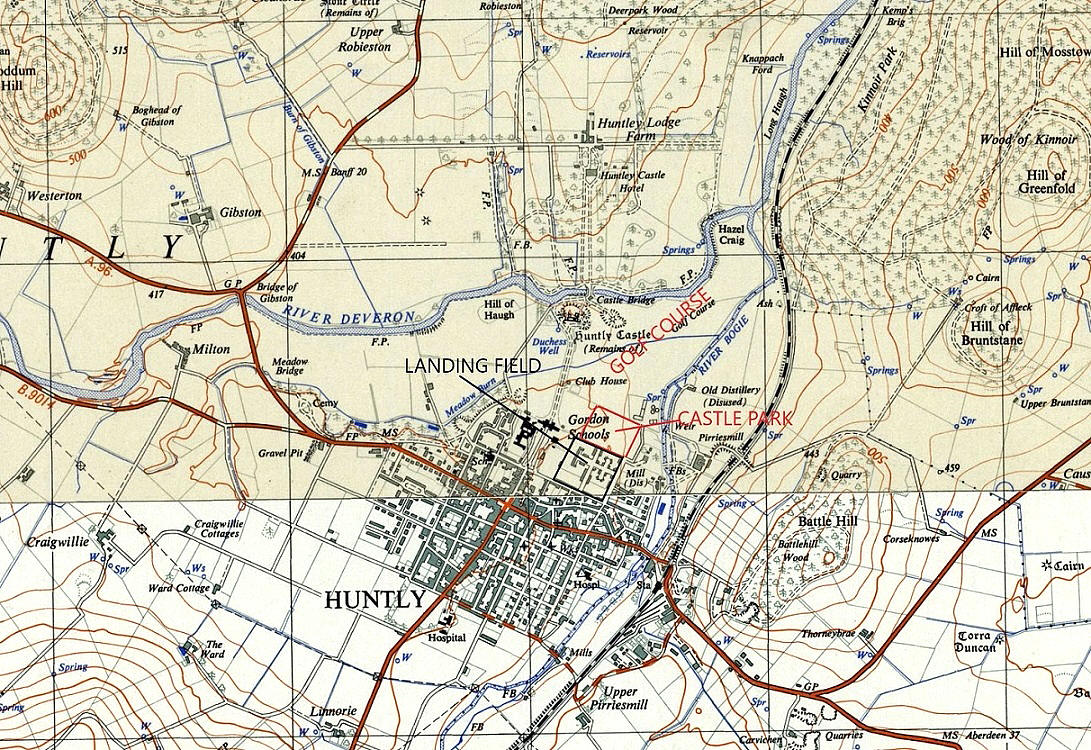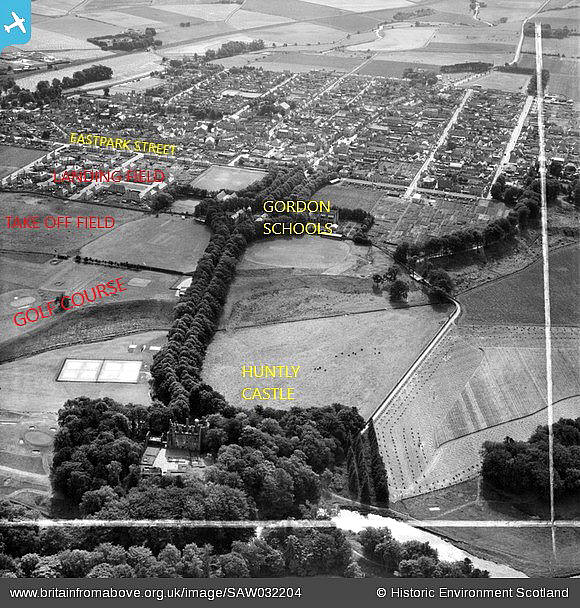Huntly 1910
HUNTLY: Temporary flying site
Note: All four of these images were kindly provided by Mr Michael T Holder
Operated by: Mr Graham Gilmour
Location: Just NE of Huntly town centre, which is on the conjunction of the A96, A97 and the eastern end of the A920
Period of operation: 4th August 1910
NOTES: Although HUNTLY is also listed in this 'Guide' (see seperate entry), this must surely warrant an entry all of its own. This was at the dawn of powered flying in the UK, so doubly astonishing to find this happening so far north in the UK.
I have to thank Mike Holder, a great friend of this 'Guide' for this quite exceptional piece of research. Mike incidentally served as a RAF navigator on Vulcans, Comets and Nimrods, so does know his way around! Here is his report, gleaned from contemporary newspaper articles which of course were, and still are, mostly very unreliable, especially regarding detail:
"On the 4th August 1910 Graham Gilmour flew a Blériot Monoplane at about 8 o'clock in the evening for a few minutes to the north of Huntly. From about four different newspaper reports it is possible to piece together the probably flight path he took. The machine was brought from Aberdeen by train and taken up to the flying site by lorry and reassembled in a shed."
"He certainly started in the Castle Park area and after his aircraft was pulled out of the shed it had been stored in, the engine was started and it was pushed down towards the Golf Course to get the maximum take off run."
"He had waited all day for the wind to die down and it wasn't until late in the evening that it dropped to below 8 knots. In general as evening approaches the temperature drops, the air gets denser and the wind speed decreases. So for the patient few thousand who stayed behind, they were rewarded by Mr Gilmour's decision that he had had enough of Bernoulli's* principles to get him airborne and complete a circuit."
*My note: Daniel Bernoulli was a Swiss mathematician and physicist, (1700 - 1785), who did pioneering work on fluid dynamics - which includes air of course. It was he who discovered that, amongst other aspects, as pressure decreases speeds increase. So, when you hear weather forecasters predict the arrival of a low pressure system - get ready for higher winds.
It also needs to be remembered that in the early days, just a small rise in temperature, and decrease in air pressure, could easily be the difference between getting airborne and staying wedded to the ground. For example, the reason Blériot landed in the depression in the cliffs at Dover, was simply because his aeroplane did not have enough performance to fly over the cliffs - even on a good day.
"He took off in a south-westerly direction and turned away from the town and then "flew in a semicircle" before landing on the ground next to Eastpark Street - the field adjacent to the take off field. I think what they meant was after flying away to the west for a short while - he then flew in a semi-circle to line up for the approach to the landing field so completing a full 360º turn. I'm sure he did not fly west and then turn through 180º and land down wind.
Note: Both kindly provided by Mr Michael T Holder: The two pictures are kindly reproduced from an Aberdeen Press and Journal article published on Saturday 6th August 1910.
"I have marked his probable route on the map. Gordon Schools is on a slight ridge and he disappeared from sight after take off before reappearing again heading back towards the spectators. The trees would have certainly cut down the view."
"He took off in nearly total silence from the crowd - it was only once he was airborne they began to cheer. Perhaps they were holding their breath hoping nothing untoward would happen. Once back on the ground the crowd rushed forward and the plane was protected from over excited spectators by twelve of the finest constabulary!"
What is not explained is why, of all places, Gilmour decided on Huntly to make this demonstration? In those days, and beyond until WW1, huge crowds could be guaranteed at major towns and cities, often with a public holiday being declared, and always a civic reception at the town hall. Usually with just one pilot and his aeroplane, (sometimes two aeroplanes). But we must remember that the vast majority of the population had never seen an aeroplane. Let alone one actually flying.
In many ways the equivalent of the space flights and moon landing half a century later.
We'd love to hear from you, so please scroll down to leave a comment!
Leave a comment ...
Copyright (c) UK Airfield Guide





















